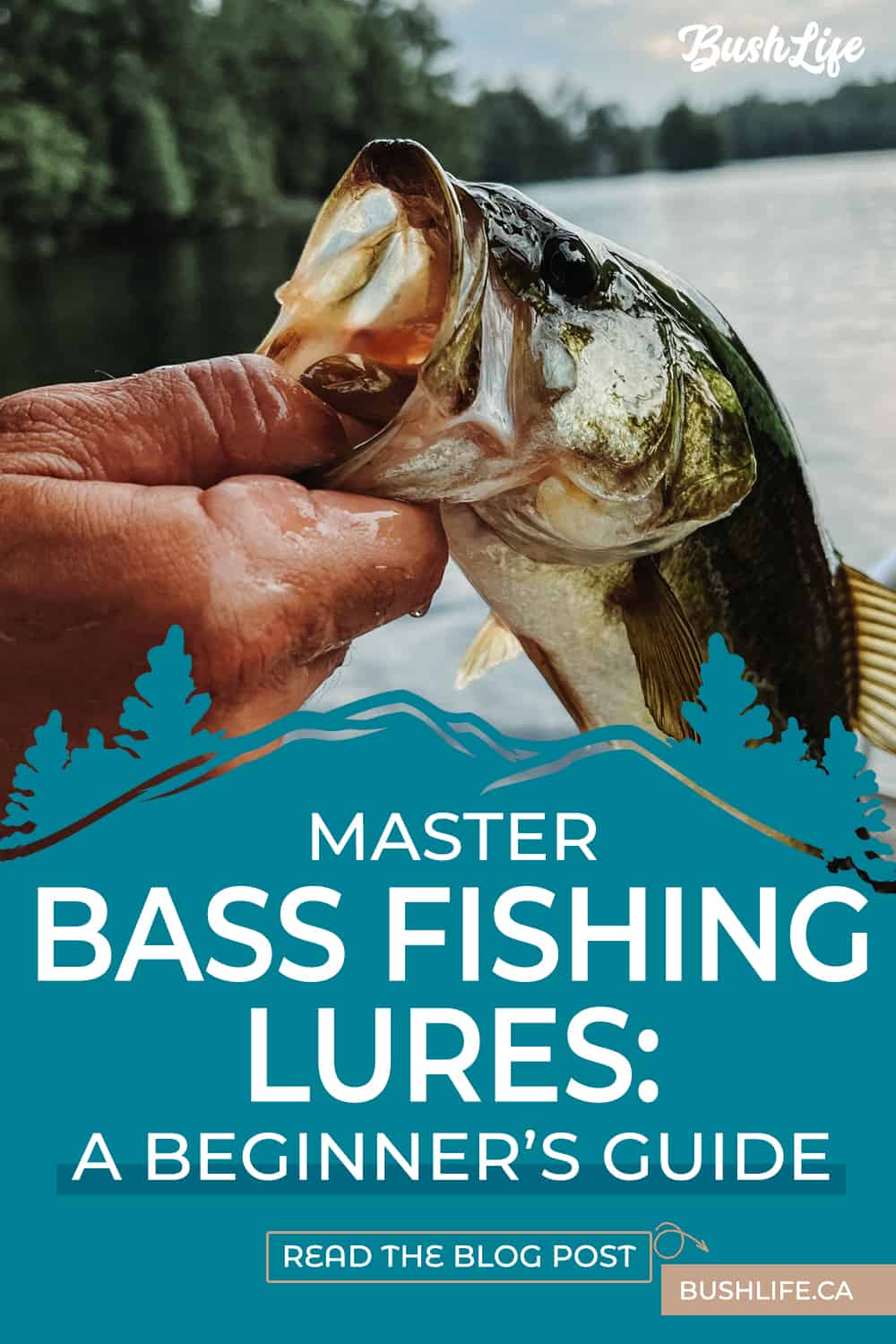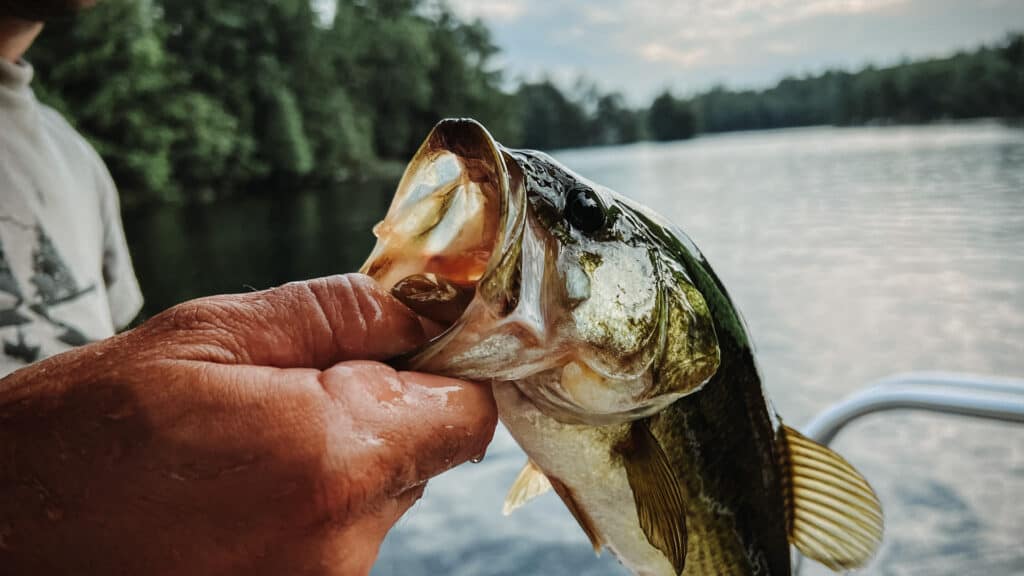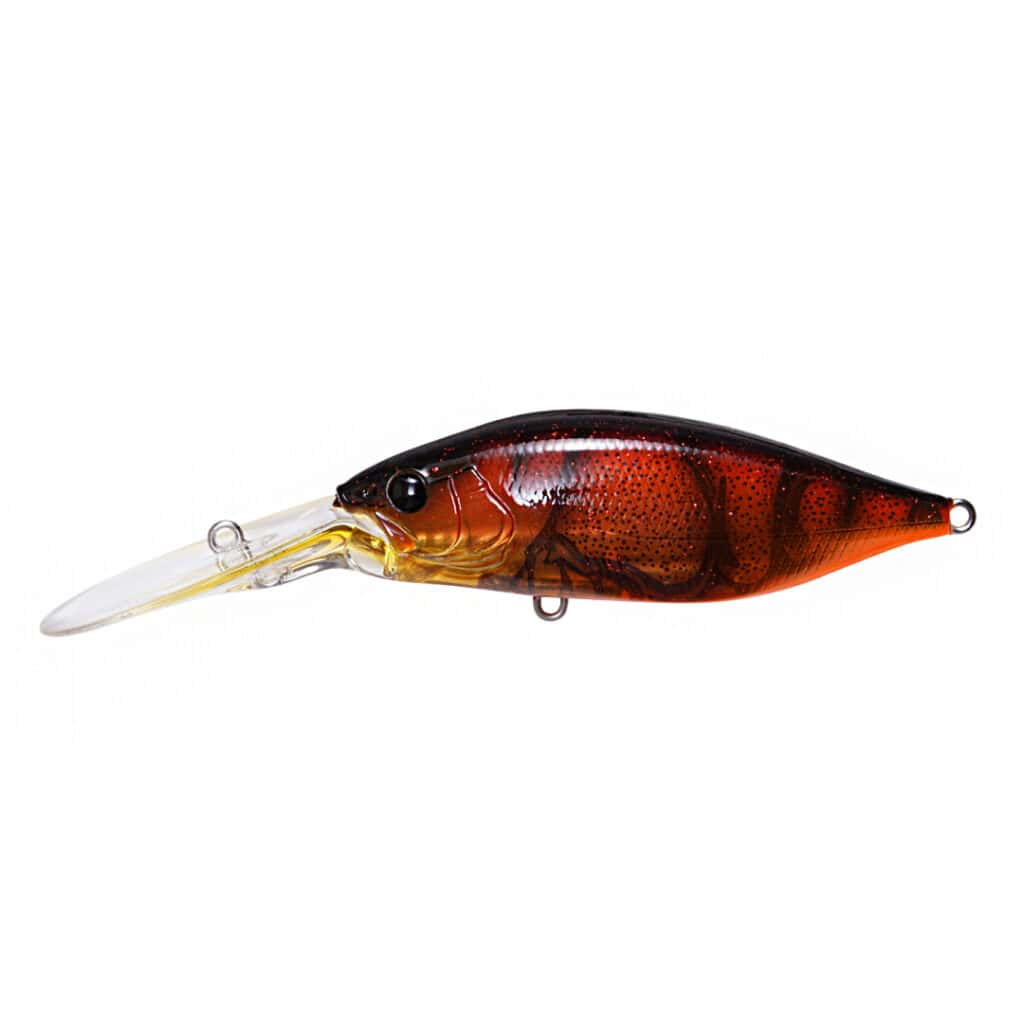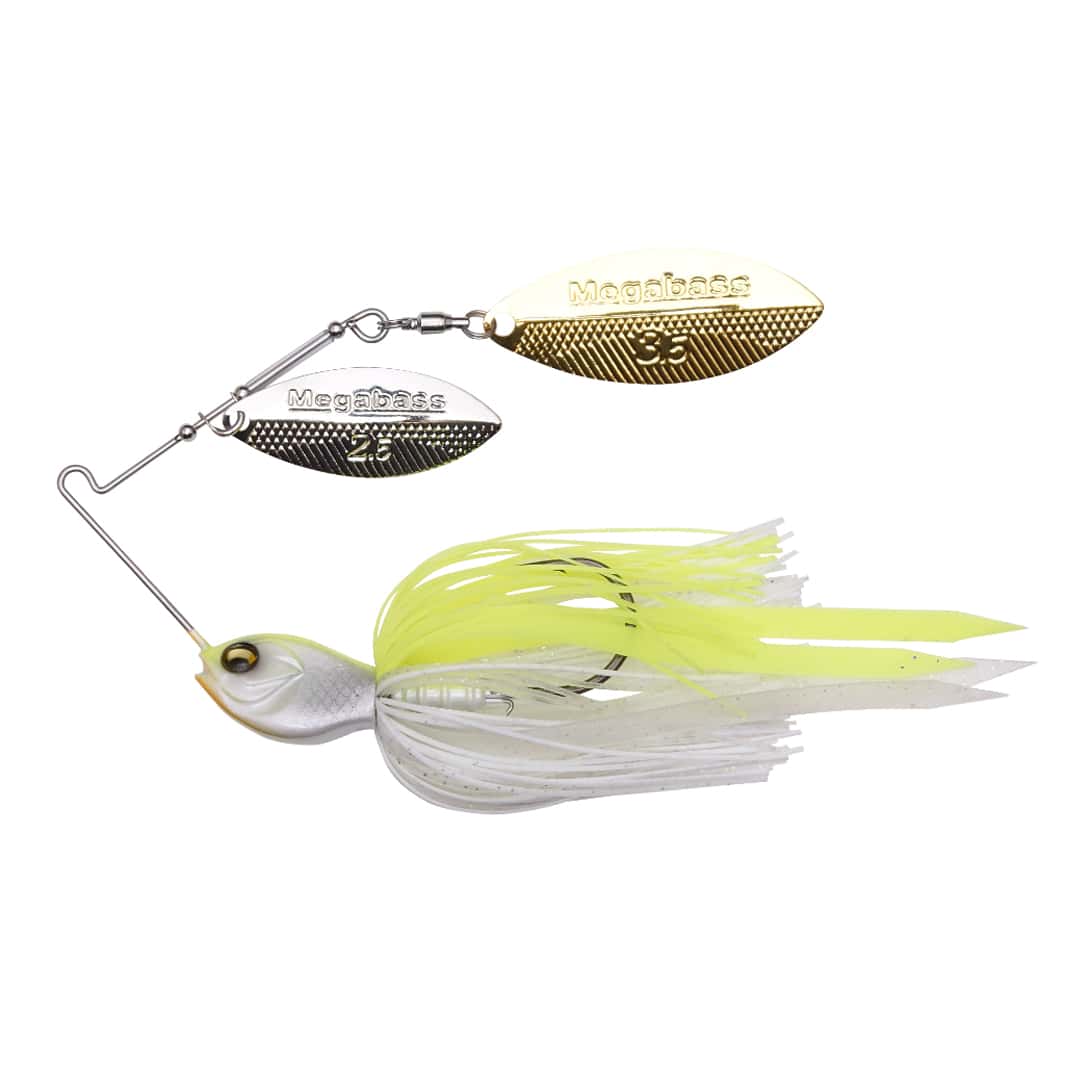Are you having trouble catching that largemouth bass? Using the best bass fishing lures can make all the difference, as does technique!
With an overwhelming array of options, finding the perfect bass fishing lure can seem like casting into a vast sea of choices. But worry not because we’ll equip you with the knowledge you need to select the best bass fishing lures for your next fishing trip.
Spread the Love
Disclosure: Posts may contain affiliate links. Purchases made through our links result in a small commission to us at no charge to you. We only recommend products that meet our brand standards based on testing and first hand use by our authors.
This post is all about bass fishing lures, especially for beginners. It covers the different types of lures you can use and shares tips to help you catch more fish. The goal is to make you familiar with what’s out there so you can pick the right lure when you head out. We’ll also give some simple techniques to increase your chances of catching bass. Get your gear ready because bass fishing is all about the thrill of landing big fish. Whether you’re new or have some experience, learning about lures and tips can help you enjoy your time on the water more.
- Top 5 Types of Bass Fishing Lures
- Factors to Consider When Choosing Bass Fishing Baits for Bass
- Best Bass Lures for Beginners
- Techniques for Using Bass Fishing Lures Effectively
- First Bass Fishing Lure Maintenance and Care Tips
- Where to Buy the Best Bass Baits and Lures
- Recommended Bass Fishing Lures Resources
- Don't Make These Mistakes When Choosing a Bass Lure
- Conclusion: Finding the Perfect Bass Fishing Lures for Beginners
Top 5 Types of Bass Fishing Lures
All artificial lures on the market are carefully engineered to imitate a specific type of baitfish or prey. Your chances of success increase when you know which types of bass lures to select, the colour, when to use it and the correct presentation.
Ideally, you are trying to mimic the local baitfish in the area. All this has to factor in water temperatures, clarity, weather, baitfish movement, season, etc. So, let’s explore the top 5 types of lures for bass and give you a comprehensive understanding of their characteristics.
Crankbaits

One of the most common types of bass fishing lures is the crankbait and one of the best bass lures for beginners to use. These are the most effective bass lures that imitate injured or fleeing baitfish, creating erratic movements that entice bass to strike.
Lipped vs Lipless Crankbait
There are different types of crankbaits, such as the lipless and lipped. The diving lip allows the crankbait to dive to a specific depth when retrieved. Diving depth varies from the size and shape of the lip.
Lipless crankbaits, excel in shallow water, but can be used at any depth and are commonly used in the spring and fall.
Crankbaits also come in various colours, shapes and sizes. Some brands, like MegaBass, are known for making super-realistic baits. It’s crazy how they can get it to closely resemble a real baitfish.
Understanding the diving depth of a crankbait is crucial, as it allows you to target specific areas of the water column where bass are likely to be feeding. Go too deep, and all you’re doing is deweeding the lake! I love pulling cranks – they are my go-to lure. They also make an excellent beginner bass fishing lure. Over the years, I’ve learned how to keep a crank hovering just above the vegetation. And the strikes it gets are simply glorious!!
Spinnerbait
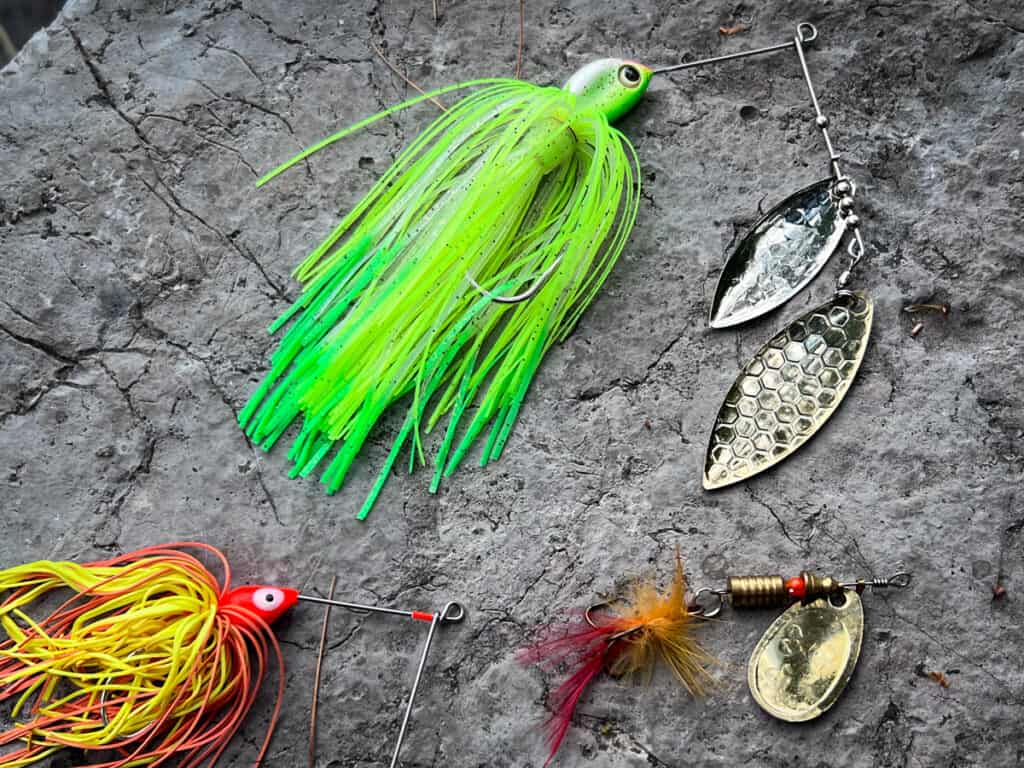
Another type of lure for bass is the spinnerbait, my husband’s favourite. It consists of 1 or more metal blades that spin with a skirted jig on the opposite end. As you retrieve the fishing lure through the water, the blade(s) create vibrations and flashes that mimic a small school of baitfish, catching the attention of nearby bass.
Spinnerbaits are popular fishing lures amongst anglers for their versatility and effectiveness in various water conditions.
When fishing weedbeds specifically, the spinnerbait is your best friend. Unlike triple hooks, the spinnerbait is better at breaking through weeds. More importantly, as the lure pops and bounces off the weeds, it often gets a good reaction strike.
Jigs
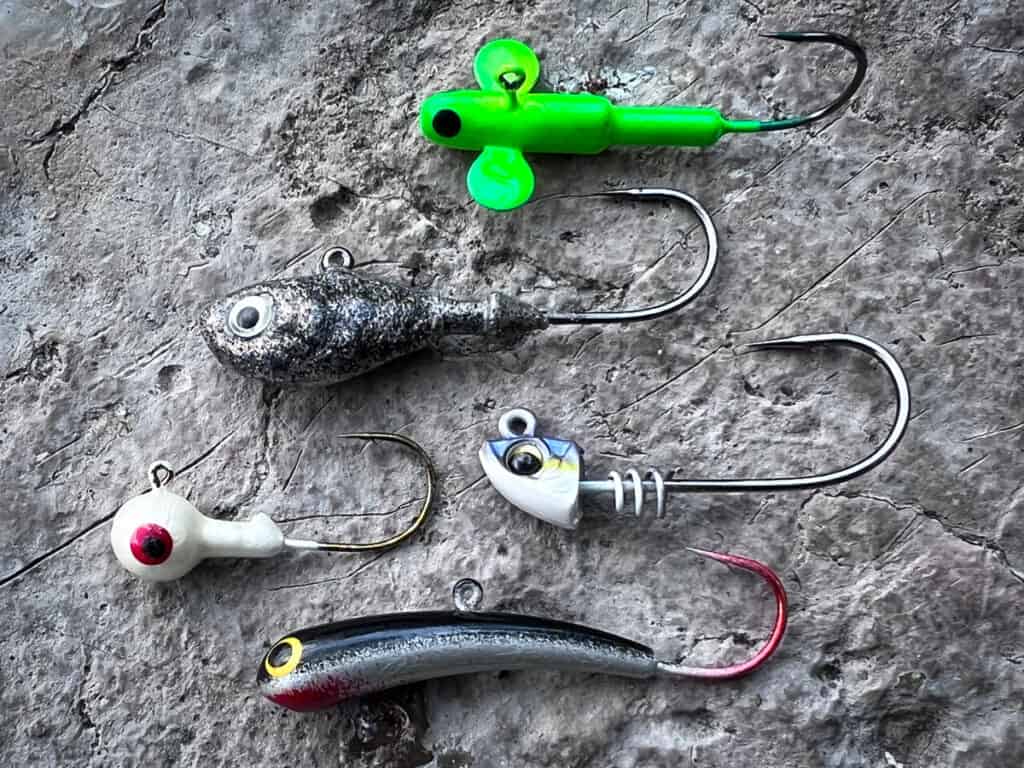
Jigs are another essential type of bass fishing lure. These lures consist of a weighted head and a trailer, which can be a soft plastic bait or a skirted jig. Bass fishing jigs are incredibly versatile and can be fished using various methods, such as dragging them along the bottom or flipping them into heavy cover.
Their realistic appearance and slow, methodical movements often trigger bass to strike. When you find your other bass fishing lures not producing results, this is the time when you want to use a jig.
Soft Plastic Bait
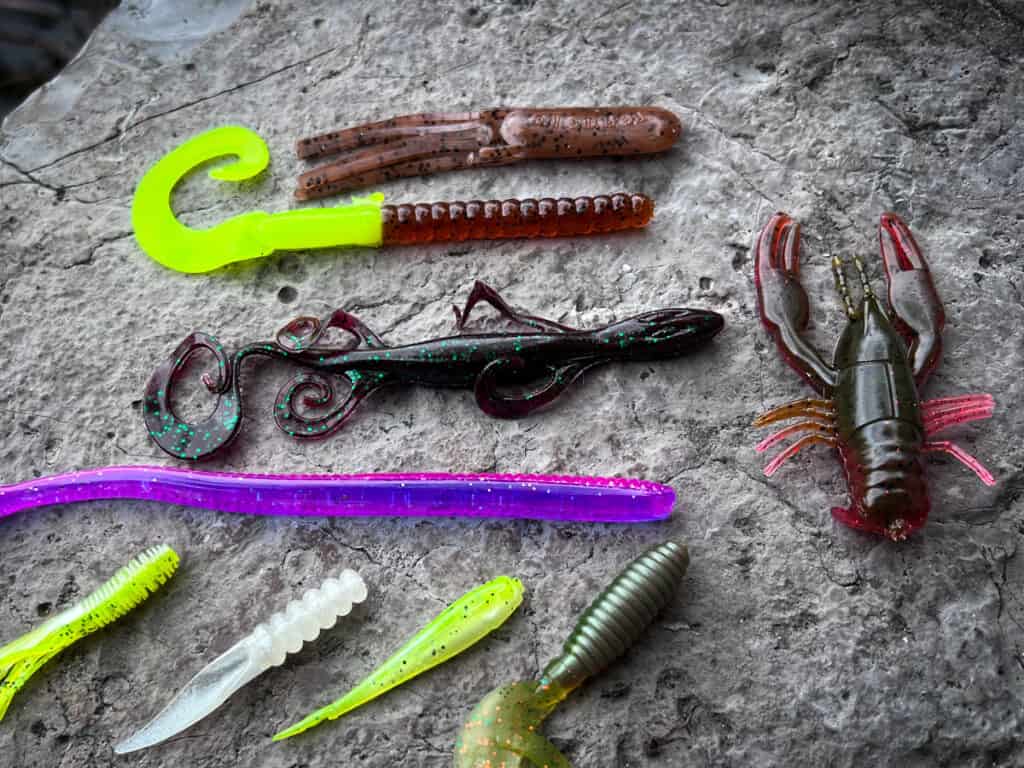
Soft plastic baits are another category of bass fishing lures that every beginner should be familiar with. These lures come in various shapes and sizes, including worms, creature baits, swimbaits, and tube bait, and can be rigged with different hooks and weights. You’ll also notice that the tails vary from straight to curl-tail.
The key to using soft plastic baits effectively is to imitate the movement and behaviour of natural prey. No straight retrieve! When was the last time you saw a worm crawl or swim in a straight line?
Our Favorite Plastics: Yamamoto Senko 5″ Worms
Topwater Lures
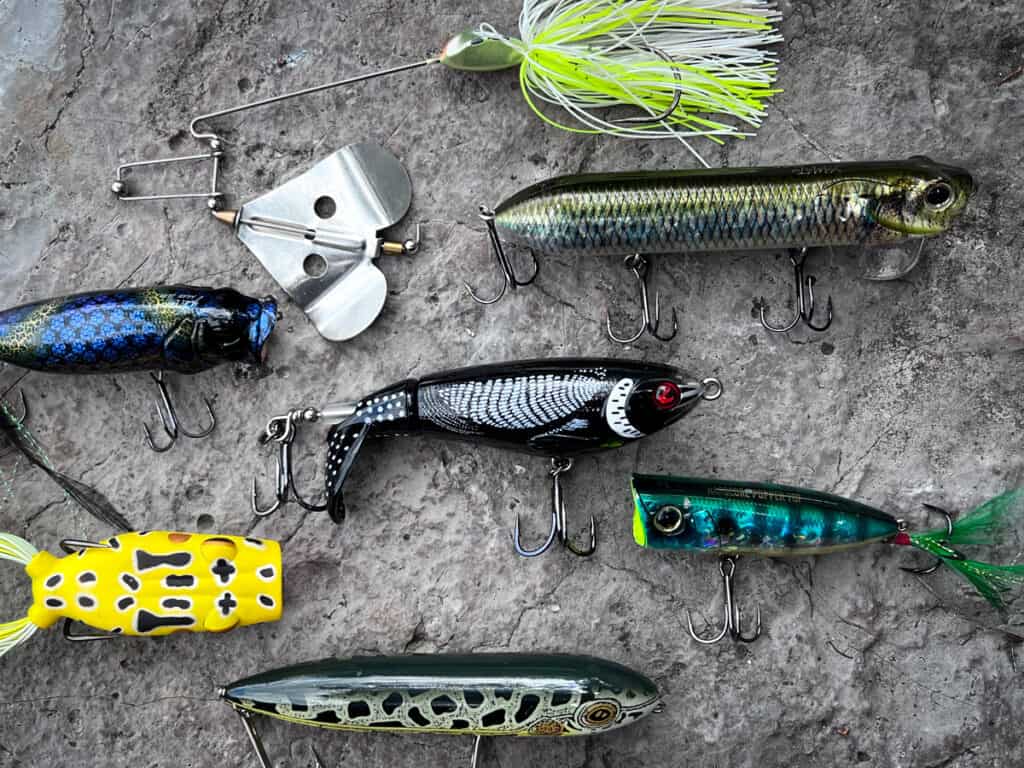
Topwater lures are super exciting and can yield an impressive and memorable strike. These fishing lures excel in calm water conditions or when bass actively feeds near the surface. Bass love swimming under lily pads, using a frog will help you skip the pads and entice a bite. Look for colours that are green, green pumpkin, yellow, white or blue, which will yield more favourable results.
This surface lure category includes buzz bait, frogs, whopper ploppers, walking bait, poppers, darters, prop baits, crawlers, etc.
Our Favourite and Best Bass Topwater Lures:
Poppers: Shimano World Pop, Megabass Popmax
Walking Bait: Teckle Kicknocker
Buzzbait: Megabass Jamaica Boa
Whopper Plopper: River2Sea 110 (4 3/8″)
Factors to Consider When Choosing Bass Fishing Baits for Bass
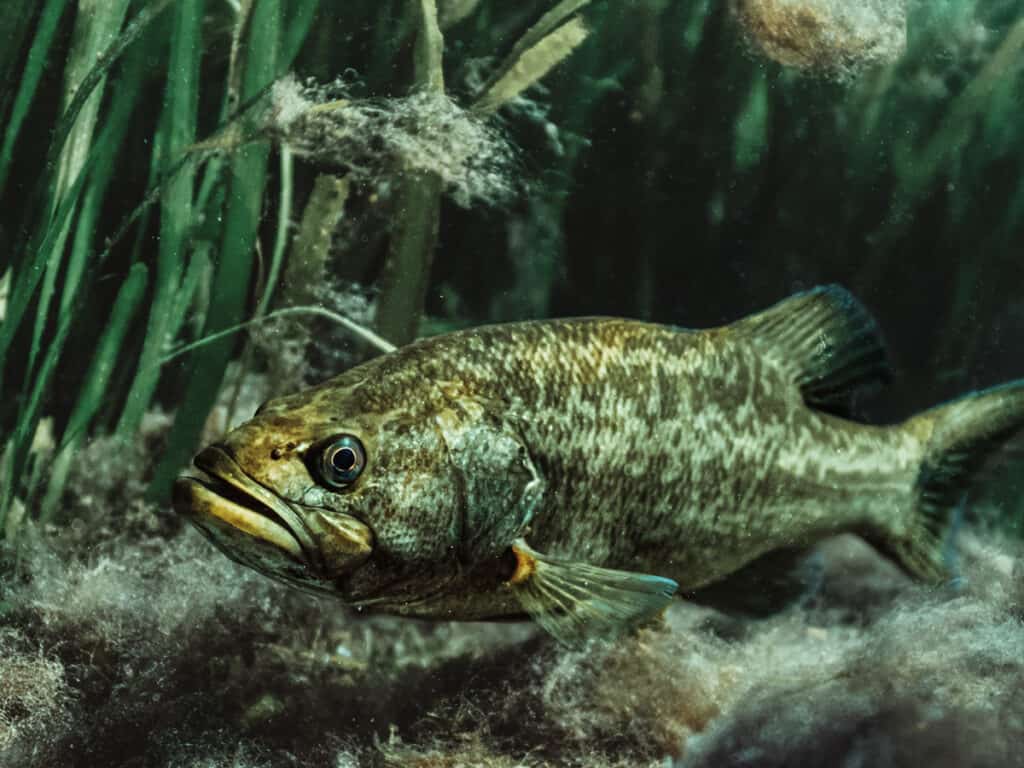
Now that you know what types of bass fishing lures are out there, there are a few key factors to consider before purchasing your very first or hundredth best bass fishing lure. First and foremost is understanding the prevailing conditions of the water; this is so crucial as different fishing lures excel in different situations. Let’s start with assessing:
1. Water Temperature
Water temperature plays a significant role in determining how the bass will behave and their willingness to strike. In cold waters, bass are sluggish and less likely to chase down fast-moving lures. Therefore, you should opt for a slower, more subtle lure like a high-quality jig or a soft plastic worm. On the other hand, in warmer water, the bass is often more active and aggressive, making topwater lures or fast-moving crankbaits more effective.
2. Water Clarity
The clarity of the water is another factor to consider. In clear water, bass rely more on vision to locate prey, so using artificial lures that closely resemble natural baitfish or critters can be highly effective. If you find yourself in murky or muddy water, lures with a sizeable profile or fishing lures that create more vibration or noise can help the bass locate and strike your bait. Fish, in general, will often sense a lure’s vibration and begin the chase long before they actually see the fishing lure.
3. Weather Conditions
Weather conditions also play a role in fishing lure selection. On bright, sunny days, bass might seek shelter in deeper water or under cover, so lures that can be worked in those areas, such as curl-tail jigs or Texas-rigged soft plastics, can be effective. On cloudy or overcast days, bass may be more likely to roam and feed in shallower water, making topwater lures or shallow-running crankbaits a good choice.
4. Depth
Consider the feeding behaviour of the fish, which can be a massive element in lure selection. Are the fish actively feeding on the surface or near the bottom? Other times, bass are found suspended in the water column, which can be the most difficult.
5. Presentation
Remember to vary your presentation if things aren’t working! The bass may be chasing down fast-moving prey or prefer slower-moving offerings. Sometimes, the lure is not the issue, rather than the speed of the retrieve. Be sure to change your retrieval to see if it sparks more bites.
If you’re having one of those days when nothing seems to work, try changing lures based on vertical versus horizontal presentation. Ie. If you know the fish are there, and a bass fishing jig isn’t working, try a spinnerbait and vice versa.
With careful consideration, selecting the correct fishing lure for the conditions and behaviour can vastly improve your chances of landing a trophy-size bass. Be sure to have a variety of bass baits in your tackle box and be ready to experiment with different techniques. As conditions change, adjust your approach based on what the bass are telling you.
Best Bass Lures for Beginners
With fishing conditions and bass behaviour in mind, having the top bass fishing lures in your tackle box can further enhance your success as a beginner bass angler. Not only are these recommended for beginners, these lures are also the top choices for professional anglers. If you’re looking for an all-around rod, opt for a medium powered rod, fast action in a 6’6” to 7’ range.
1. Spinnerbaits
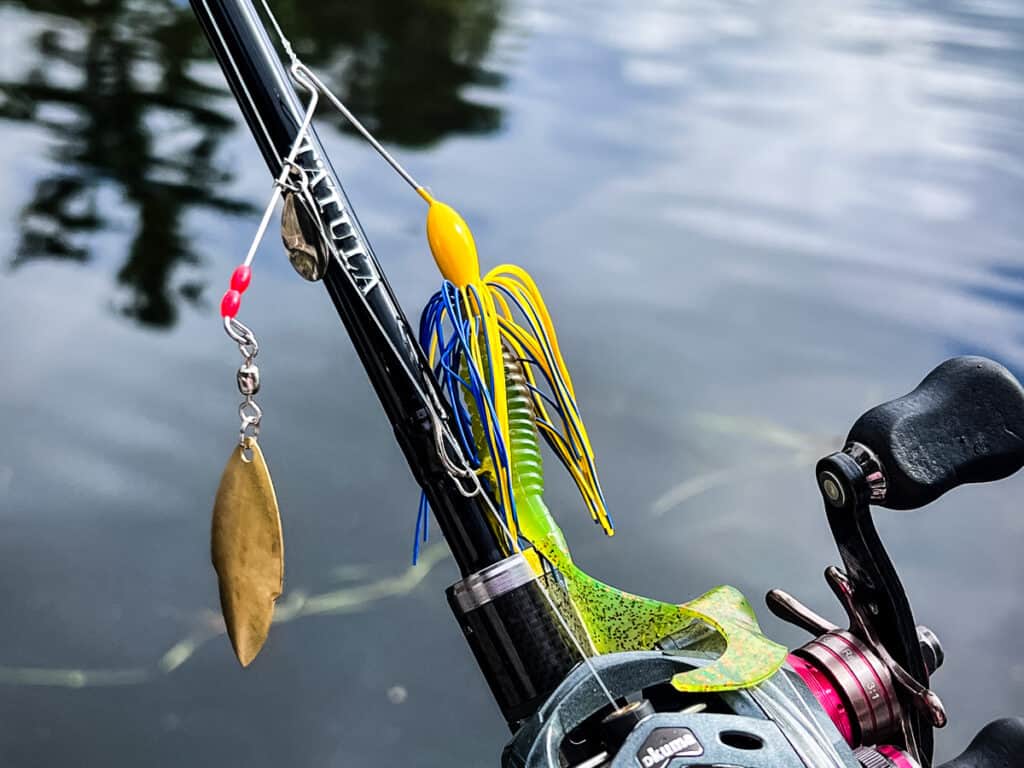
As mentioned earlier, spinbaits consist of a metal blade that spins as you retrieve the fishing lure through the water, creating vibrations and flashes that catch the attention of nearby bass. Spinnerbaits can be effective when the water is murky – or the bass is actively feeding on the surface. Spinnerbaits are my go-to when dealing with heavy weed cover.
Bass love spinnerbaits in chartreuse with a pinch of orange or in black and blue. You will need a medium heavy rod to use the spinnerbait with. For beginners, you can get away with using a spinning rod, but a baitcaster is much preferred. There is a learning curve to using a casting rod, but it allows for greater control.
Be forewarned, spinnerbaits are extremely effective, but finicky – you need to master proper techniques to use these, otherwise you’re wasting your time. You’ll be using a slow, steady retrieve.
2. Soft Plastic Worms
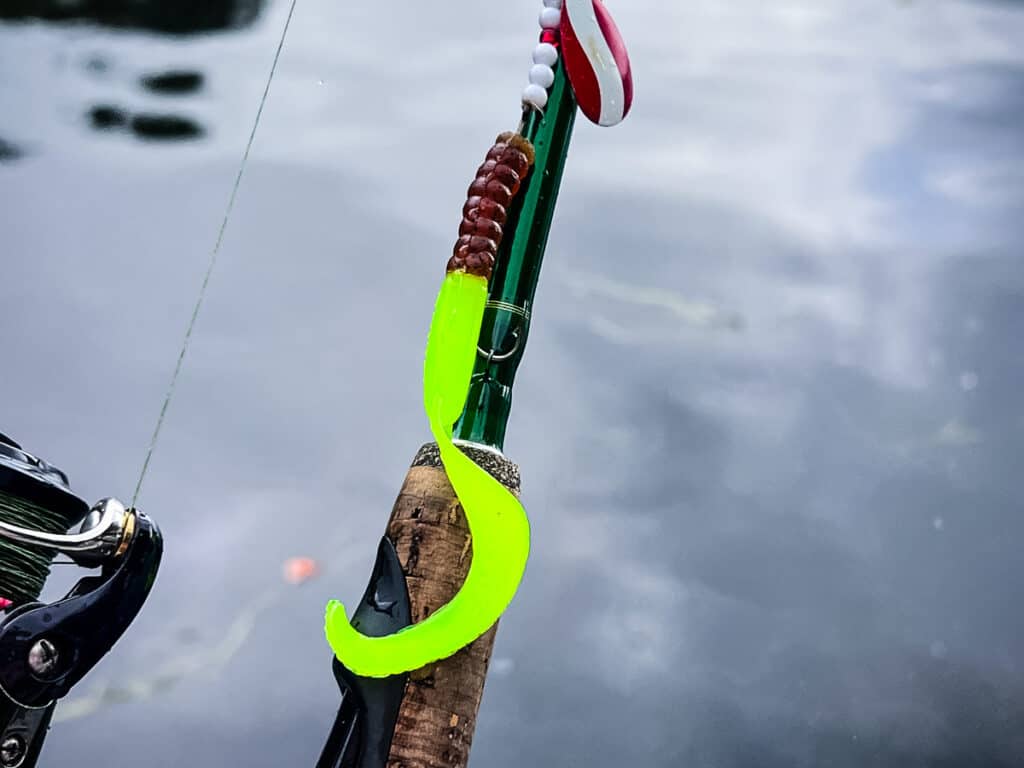
Soft plastic worms are especially effective when bass are in a more sluggish, less aggressive mood. Consider bright-coloured soft plastic lures in murky water and natural colours in clear water. Over the years, our goto plastic worms have been the natural colour with a yellow curl-tail or black with a pink fire tail.
Plastics are more of a “finesse” technique and can be rigged in various fashions such as wacky, Texas rig, drop shot or Carolina rig. Texas rigs are the go-to for heavy weed cover and shallow water, and drop shot is suited for those times you want to set your worms to be at a specific depth off the bottom. You can also set up drop shots in a weedless fashion. Carolina rigs are suitable for fishing deep water.
Depending on the technique you use – you’ll want to use a lighter medium action rod between 6’5” to 7’ long. Some anglers will opt for a medium, fast action – again, it all depends on the setup you go with. If you’re ned rigging, you’ll want a light powered rod.
3. Crankbaits
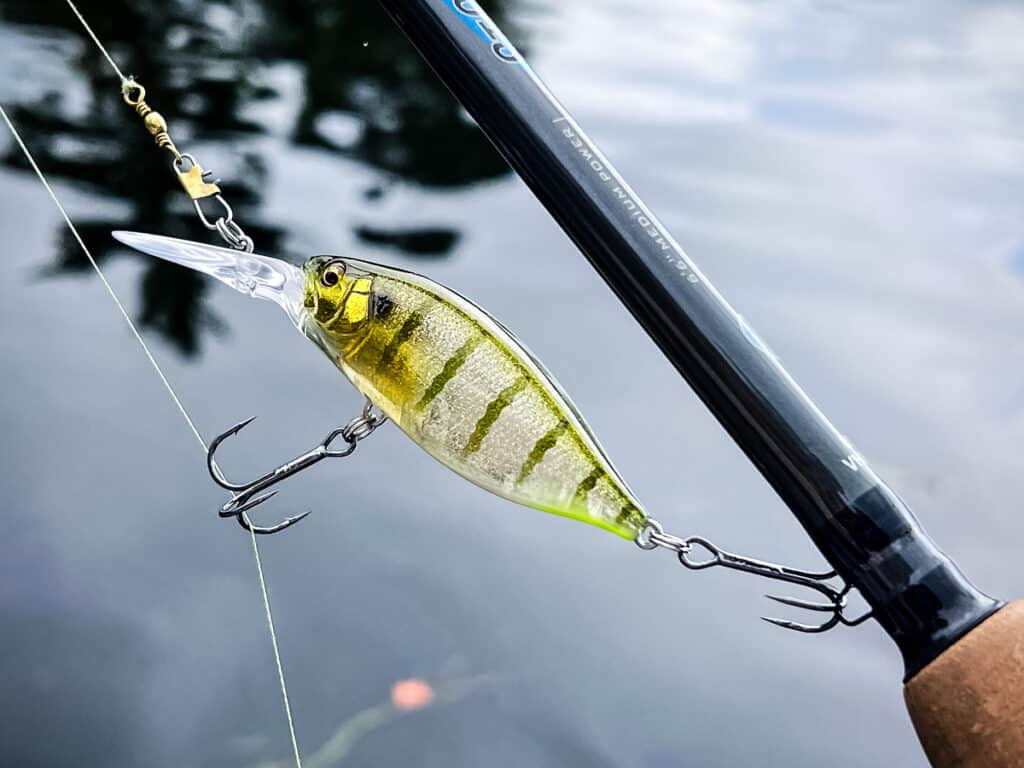
Crankbaits are also a favourite for first time bass fishing, as they are effective in areas with submerged structures or when bass are actively chasing fast-moving prey. Colours similar to the waterbody’s baitfish do better in cold water, whereas bright crankbaits fare well in warmer waters. Again, chartreuse with blue is a favourite in early summer. Towards the tailend of summer, you’ll work your way over to colours resembling baitfish – like a bluegill pattern, greens, blues, natural looking.
Crankbaits are easier to fish. Most beginner anglers go with a straight retrieve, but if you can master changing your speed and pausing, your chances of hooking a giant largemouth bass go up ten-fold. Make sure you delay setting the hook – give the bass a chance to swallow.
When fishing with cranks, you want a rod with more flex with an action of 50/50 or 60/40. You want the rod tip to be soft as bass do not like to be caught. Hard tips make it easier for the bass to fling off. Use a rod that is between 6’6” to 7’6”. I’ll use a 6’6” rod, whereas my husband prefers a 7’1”.
4. Topwater Lures
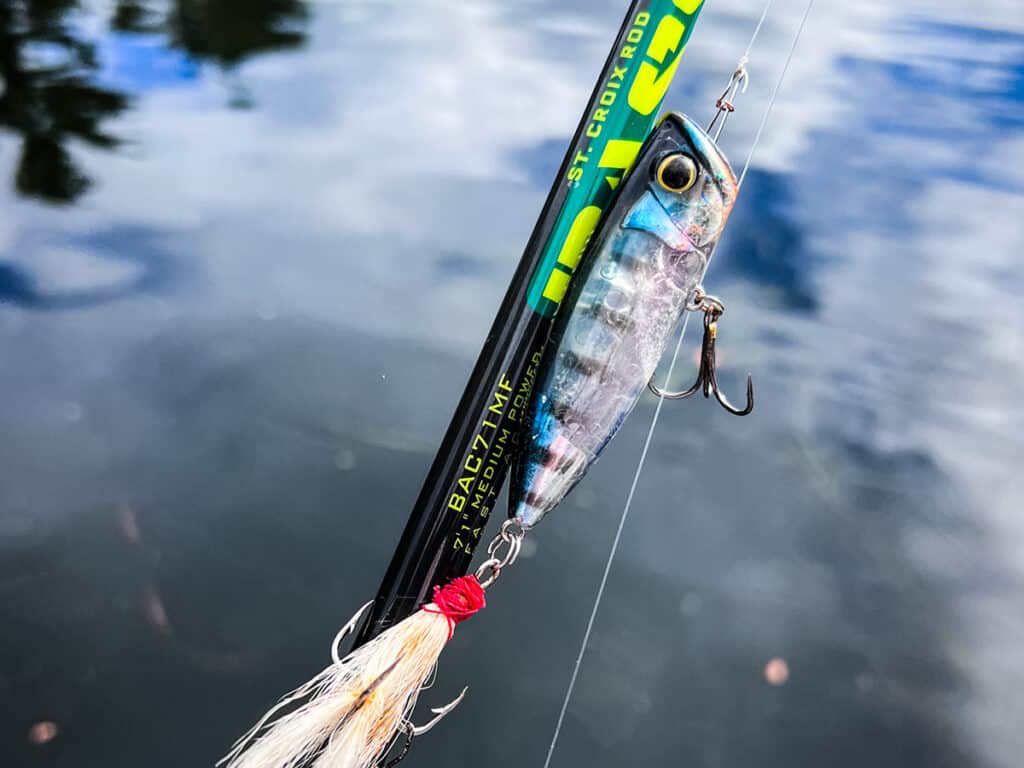
Topwater lures are super exciting and can yield an impressive and memorable strike. These fishing lures excel in calm water conditions or when bass actively feeds near the surface. Look for colours that are green, green pumpkin, yellow, white or blue, which will yield more favourable results.
Remember, the key to success is to have a varied selection of lures in your tackle box. Bass will not respond to the same old fishing lure used every time, especially in busy open water with anglers throwing everything at them.
For topwater lures, use a rod that is medium powered with a fast tip – here you’ll want to use a shorter rod between 6’6” and 7’.
Techniques for Using Bass Fishing Lures Effectively
The key to hooking a trophy bass is to vary your technique. Beginner anglers struggle with hooking up a fish as their technique usually involves a straight retrieve. Whether it be a slow or quick retrieve, no prey in the water moves in a straight line. Let’s look at some techniques that you can practice and perfect.
Fishing Techniques for Topwater Lures
When using topwater lures for bass, it’s all about creating a realistic action that entices bass to strike. These lures float on the surface and imitate various types of prey, such as frogs, mice, or injured baitfish. To effectively work these lures, try using a series of twitches, pauses, and retrieves, which creates the illusion of struggling prey.
Crankbait Fishing Techniques
For crankbaits, the key is to mimic the movements of injured or fleeing baitfish. To use your crankbait lure for bass fishing effectively, do a long cast out and reel the crankbait in at a steady pace. Vary the speed (which affects depth) of your retrieves to imitate the erratic movements of wounded baitfish. You can also try fast cranks of the reel with pauses in between or even burning the lure and sweeping the rod occasionally to get the fishing lure to bounce off a hard bottom and get that reaction strike.
Spinnerbait Techniques for Bass Fishing
The key to using spinnerbaits effectively is to vary your retrieve speed (and depth). Start by casting the spinnerbait out and reeling it in at a medium speed. If you’re not getting bites, try slowing down and slow-roll along the bottom. Finally, you can also speed up and burn the lure just under the surface – this doesn’t give the bass time to look (and think), which leads to a satisfying reaction strike.
Experiment with different depths by choosing different spinnerbaits based on weight or adding a trailer. And, of course, this goes back to retrieve speed – the slower, the deeper the lure goes.
Effective Jigging Techniques
To effectively use jigs, cast the bass fishing jig out and let it sink to the bottom. Once the jig reaches the desired depth, use a series of short hops and pauses to imitate a crayfish or other bottom-dwelling prey. Pay close attention to any subtle taps or pressure on the line, which could indicate a bass has taken the bait. Jigs are especially effective when bass are holding near cover or in areas with dense vegetation. Also, aim for an instant hookset with jigs, as fish will spit the lure out quickly when they bite on all that metal.
First Bass Fishing Lure Maintenance and Care Tips
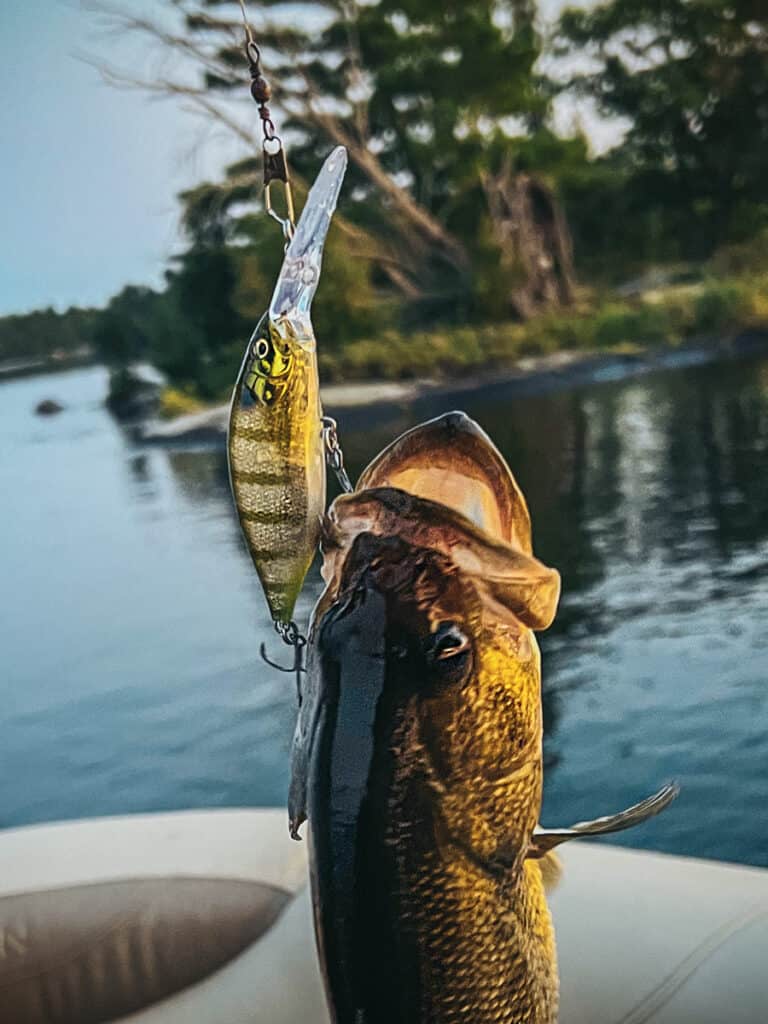
Wow, was that ever a lot to take in? Hopefully, your bass lure knowledge has increased drastically. Before you go, as with anything, maintaining your lures and baits is very important. After a day of fishing, we all mindlessly make the mistake of tossing our wet fishing lures into a tackle box only to find the lure peeling or with rusty hooks.
The feeling is gut-wrenching when you have a good-sized fish on your hook, which suddenly breaks or is not sharp enough to puncture the lip. This feeling gets worse if you’ve been fishing all day and it was your only hook-up. Here are a few housekeeping tips to ensure the longevity of your fishing lures:
Tip #1
Tip #2
Tip #3
Tip #4
Tip #5
Where to Buy the Best Bass Baits and Lures
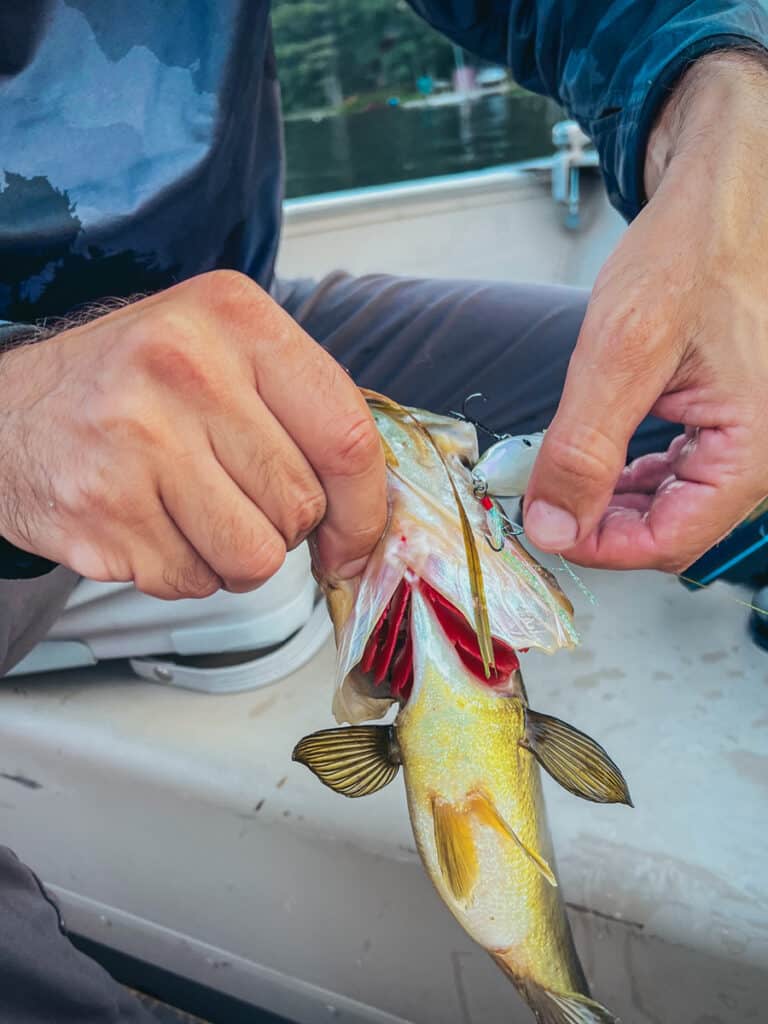
With the increasing popularity of bass fishing, finding a wide range of the best lures for fishing is easier than ever.
For in-store experience, check out your local sporting goods store like Sail or BassPro. Specialty fishing tackle stores like Peterborough Pro Tackle in Canada and The Hook Up in the US carry more of a mid to higher end fishing gear. These establishments often have knowledgeable staff who can provide advice and recommendations based on their experience, your skill level and fishing preferences, and of course, budget.
A word to the wise – knowledgeable staff tend to sell you what they use in their particular body of water, what may not be selling well in the store or the latest, expensive, untested lures – so be careful when putting your trust into others. Check with your fishing buddies first or ask around.
If you prefer to go the online route – you atleast have access to customer reviews, an extensive selection of fishing lures and discounts. Making it easier to find affordable yet effective fishing lures for beginners.
[the_ad id=”15886″]
Recommended Bass Fishing Lures Resources

There are many ways to learn about bass fishing lures. You can read books, watch videos, or join online forums. These resources give helpful tips and advice to pick better lures. Picking up new skills is easy when you have a variety of options to learn from. Practice makes perfect, so keep trying different techniques and stay curious. Whether you prefer reading or watching, you’ll find plenty of info to improve your fishing game.
Most anglers like to figure out what works through trial and error. Some prefer reading popular books like “Bass Fishing 101” by Kevin VanDam or “In Pursuit of Giant Bass” by Bill Murphy. Our favourite is the Total Fishing Manual series by Field & Stream. These books are easy to read and add a bit of humour. They cover tips and tricks that help anglers improve their skills without overcomplicating things. It’s a mix of learning and having fun, which makes them popular even with seasoned fishermen.
If you learn best by seeing how things are done, videos are a great choice. There are many YouTube channels and websites showing step-by-step guides on choosing and using bass fishing lures. Channels like BassFishingHQ offer helpful videos on different fishing topics. Watching these videos can make it easier to understand how to pick and use lures the right way. They give visual tips and demos that can boost your bass fishing skills.
Joining online fishing forums like BassResource.com and Bassfishin.com lets anglers share tips and ask questions. These sites have active communities ready to answer specific questions about bass fishing. You can get advice on lures, techniques, and local spots. Sometimes, members recommend lesser-known gear or tricks that can help you catch more fish. It’s a great way to learn from others and improve your skills on the water.
Don’t Make These Mistakes When Choosing a Bass Lure
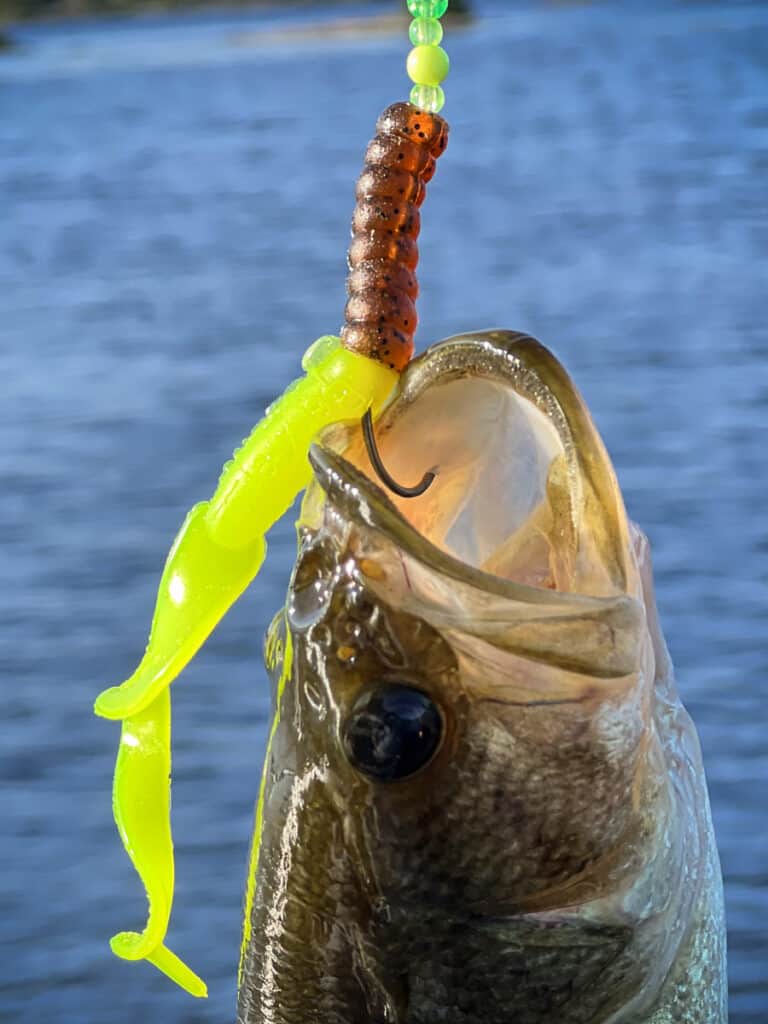
Don’t just chase after popular lures because everyone talks about them. Bass behave differently depending on water and weather conditions. What works now might not work tomorrow. Instead, learn what makes each lure special and how it suits the water you’re fishing in. Try different options and see what bass respond to in your spot. It’s better to understand your lures than to follow every trend.
Matching Lure Size to Target Bass
Overcomplicating Purchases
Lack of Adaptability
Conclusion: Finding the Perfect Bass Fishing Lures for Beginners
Choosing the best bass fishing lures for beginners is important in levelling up your fishing game. Throughout this bass fishing lure guide, we’ve explored the different types of lures, factors to consider, top choices for beginners, effective fishing techniques, maintenance tips, and even where to purchase these essential tools. Now armed with this knowledge, it’s time to put what you know into action!
So, grab your gear, hit the water, and embrace the thrill of reeling in your next big bass. Just think, with every cast, you’re one step closer to becoming a skilled angler. Good luck!
Comment your favourite bass fishing lures or colour preference. Or share with someone who you think could use these helpful tips. Thank you!
Bookmark this post on Pinterest for future reference!
